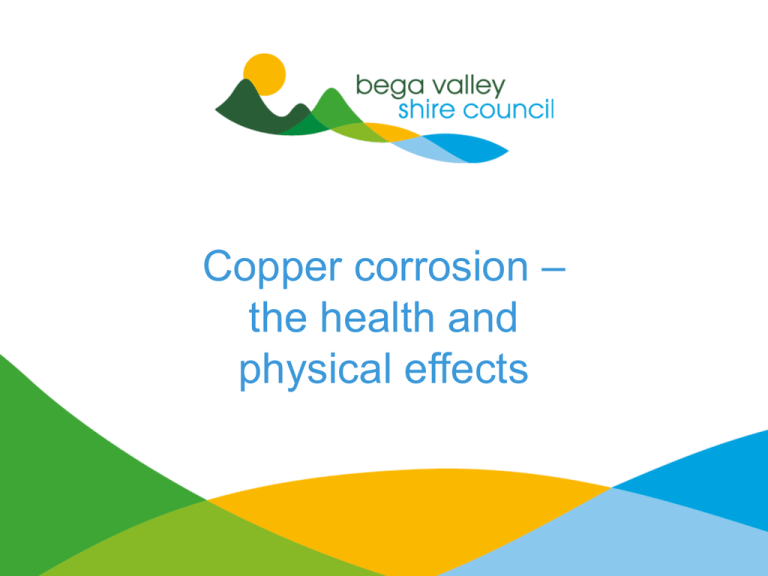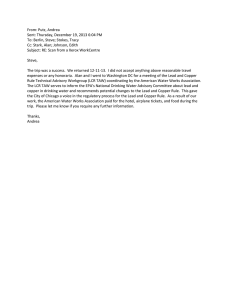Copper corrosion – the health and physical effects
advertisement

Copper corrosion – the health and physical effects What is Copper? • Copper is a metal that exists in the environment as a mineral in rocks and soil. • It is commonly found at low levels in natural water (0.05 to 0.6 typically) • It is also an essential trace element that is required to maintain good health. • Has been used in plumbing >4000 years What are the potential health effects of copper? • The normal adult requires approximately 2 to 3 mgs of copper / day to maintain good health. • Consumption of high levels of copper can cause nausea, vomiting, diarrhoea, gastric complaints and headaches. • Long term exposure over many months and years can cause liver damage and death. What are the potential health effects of copper? • The symptoms of nausea, vomiting, diarrhoea, gastric complaints and headaches are similar to many other ailments and may not be attributed in the first instance to copper toxicity. Australian Drinking Water Guidelines Australian Drinking Water Guidelines sets two levels for copper: • 1mg/L for aesthetics to prevent taste and staining problems; and • 2mg/L to prevent any health related problems • The taste threshold for copper is 3 to 5 mg/L • Acute gastric irritation may be observed in concentrations above 1.3 mg/L. How does copper get into drinking water? • The primary source of copper in drinking water are corroding pipes and fittings. • Signs of high levels of copper in drinking water include a metallic taste or blue to blue-green stains around sinks and plumbing fixtures. How does copper get into drinking water? • The long term safe performance of copper pipe is dependent on the establishment of a natural protective internal surface film of copper oxides and copper carbonates. • Through either physical, chemical or microbiological interference with this surface film corrosion of the copper pipe begins. Natural protective internal surface film How does copper get into drinking water? • AS 3500.1 states ”Copper and copper alloy pipes and fittings shall be installed in accordance with installation requirements of AS 4809”. • AS 4809 states “the service life of copper pipe installations may compromised if used to convey water that falls outside of ADWG particularly in terms of pH, Alkalinity, chloride, sulphate and residual disinfectant.” Ways copper pipe can corrode • Copper pipe can corrode: – Externally – Internally Causes of external corrosion of buried copper pipe • Exposure to abnormally corrosive/aerated soils and/or fill • Galvanic corrosion associated with exposure to dissimilar metals • Faulty design and workmanship (fluxes) • Stray electrical currents. External corrosion Causes of internal corrosion • Internal corrosion of copper water pipes is a highly complex issue that is not yet fully understood and is still subject to ongoing research. • It can occur in both treated and untreated water supplies in both large and small supplies and from both surface and bore water sources. Internal Copper Corrosion • There are four main mechanisms through which a copper pipe or fittings can cause internal corrosion problems for consumers. • They are primarily caused by either physical, chemical or microbiological interactions on the copper pipe or fittings. Erosion-Corrosion Erosion corrosion is a form of pipe failure caused by excessive velocity, dissolved gases or the presence of particulate matter. Pitting corrosion • Pitting (non-uniform) corrosion is usually associated with water composition issues, particularly but not exclusively with low pH and low alkalinity parameters. • Can affect both hot and cold water supplies more recently recirculating HWS. • Pitting corrosion is seldom associated with elevated levels of copper at taps. Pit corrosion chemistry Pitting corrosion Cuprosolvency (copper dissolving) • Generally involves a slow rate of uniform corrosion where Cu ions are retained in solution rather than precipitated out. • It is characterised by elevated levels of dissolved (soluble) copper • More prevalent in new pipes with low pH <7.0 and relatively soft or hard water. Blue water corrosion • Blue water is characterised by blue-green colouration in water when first drawn from a tap. • The blue water is a result of a finely divided insoluble flocculent of copper corrosion by-products suspended in water. • It is more frequently observed in pipes with patterns of low use Blue Water Corrosion • It almost exclusively occurs in cold, soft, poorly stabilised or low alkalinity waters. • Believed to be microbiologically induced corrosion (MIC) • MIC linked to presence of soft carbonaceous water producing biological film in pipe Factors that affect the population exposure to copper in drinking water Water composition • Water composition drastically affects copper release particularly if the water composition that falls outside the range nominated by ADWG most notably in terms of : • pH • Alkalinity • Chloride and Sulphate levels • Residual disinfectant levels ADWG recommend pH 6.5 to 8.5 to reduce corrosion risk Factors that affect the population exposure to copper in drinking water Stagnant contact time • This is a major contributing factor. • Can lead to high increases in copper concentrations depending mainly on water composition and on the age of the pipe. Factors that affect the population exposure to copper in drinking water Age of copper piping • Studies conducted in Germany and else where show that copper by product release from the pipe to the water (cuprosolvency), is much greater for new pipes rather than for old copper pipes. Factors that affect the population exposure to copper in drinking water The design and installation procedures • The liberation of copper by-products can be influenced design parameters such as: – Presence of high velocity flowing water, – Pipes in contact with different types of soil or concrete, – Differences in temperature, – excessive number of bends in the network, – electrical grounding contacts, – stresses built up in the piping system, Factors that affect the population exposure to copper in drinking water The extent of use of copper in the distribution network • The use of copper pipe in domestic installations has waned still very common in HWS, commercial and government projects. • Germany actually prohibits the use of copper when the water composition is prone to copper by product release. Factors that affect the population exposure to copper in drinking water Drinking habits of the population – the amount of water consumed – the time at which people drink water from the tap, – the location of the tap, – the use of water from the HWS. affect the total copper ingested. Case Studies Case Study One • 10 children in western NSW high school became ill after drinking water from bubblers after summer break 2004. • Elevated Cu levels of 5.7 to 42.3 mg/L • pH as low as 4.3 recorded as WTP offline. • WTP brought back online and flushing of mains resulted in Cu levels dropping to 0.67 to 1.2 mg/L. Case Study Two • September 1993 15 children in SW Sydney became ill at a tennis clinic after consuming water drawn from a distribution system that supplies potable water to a semi-rural township. • In response to a suspected outbreak of a waterborne illness the PHU investigated Case Study Two • Further testing revealed Cu levels in water ranged from 3mg/L to l7mg/L. • PHU determined elevated CU levels most likely resulted from a combination of factors: – soft, acidic water enhancing leaching of copper into the water reticulation system; and • the external tap not being flushed for some time before the tennis clinic. Case Study Three • Urban residential property provided with reticulated water supply. • Complaints of illness (nausea and vomiting) and blue/green discolouration of bathroom fixtures. • Detailed investigation by Water Utility undertaken. Case Study Four • Rural property, plastic water supply pipes, plastic rainwater tanks, colorbond roof supply. • Following installation of recirculating solar hot water system. • Elderly male presented with symptoms of nausea, vomiting, diarrhea, gastric complaints and headaches Cu blood levels 32 micromol/L (normal 11-22) • Analysis of copper levels in drinking water showed levels of 0.86 to 3.15 mg/L in both hot and cold supply Implications for Public Water suppliers • Routine monitoring through Drinking Water Monitoring Program (DWMP) should not detect the presence of Cu in internal water mains. • In areas where soft acidic water is present advice from water utility should be given about the potential for copper corrosion to be present. • EHOs have a vital role to play. Implications for Private Water Supplies • Private water suppliers are now required to have in place their QAP. • The issue of copper corrosion and the potential impact on human health may be poorly understood by the business operators and may need guidance. • EHOs can play an important role in public education The Australian Plumbers Handbook says • The composition of untreated supplies and bore water should be examined to ensure compatibility with copper prior to installation. • Untreated tank water may not be compatible with copper due to the lack of stability and potential microbiological variability. Public information on Copper Corrosion • Various State & Territory Health Departments and Large Water Utilities have provided advice on the health risks of copper corrosion via fact sheets and web based advice. • Typically the advice is based around flushing of water mains or the installation of water filters or pipe replacement. • Flushing not a viable long term option Conclusions • The whole issue of copper corrosion is very complicated and no-one fully understands it yet, despite a lot of research effort. • The health effects of copper toxicity are not well understood due to general nature of symptoms (confusion with other potential ailments eg: FBI etc.) Conclusions • Water quality varies widely across the state as such Cu corrosion rates will vary. • WSUs do not test consumer mains for water quality • EHOs have a major role to play in supporting the water supply authorities and private water suppliers and consumers in understanding issues around copper corrosion. Future Work • There needs to be more work undertaken to establish the links between presenting illnesses and the presence of elevated copper blood levels to confirm actual cases of copper poisoning. Acknowledgements Warren Matthews PHU NSW Health Dr Sandy Leask & Josh Tickell from Water Unit NSW Health Questions?



